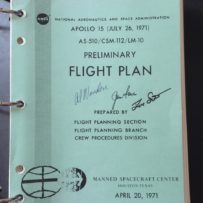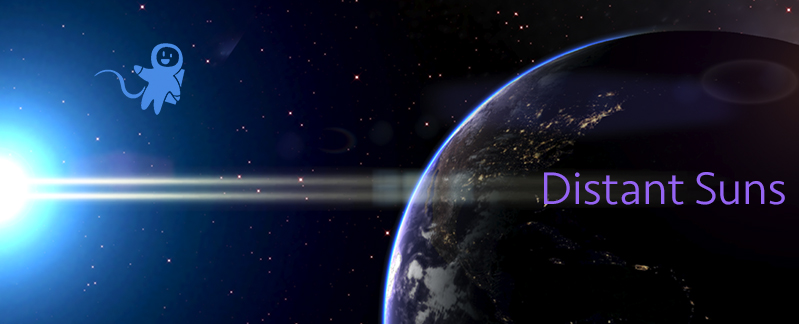Yet more weird crap in Mike’s place

Back before Apollo 15 I met someone who had a friend at the space center in Houston. I wrote him, Ron was his name, and asked for various odds and ends regarding Apollo. What I would get in the mail would lead to a lifetime of collecting, and sacrifice of anything that appeared to be the quaint notion of “savings.”
Apollo 15’s “flight plan”
Ron had sent me a copy of Apollo 15’s “flight plan” and a copy of the Apollo Operations Handbook. I had seen an Apollo flight plan before, and that was in a touring exhibition of the Apollo 11 command module that went to the capitals of all 50 states. We had waited for over four hours in the line in Sacramento, California and were rewarded by seeing the very first moon rocks on public display, miscellaneous artifacts and the Columbia spacecraft that took the crew of Neil Armstrong, Buzz Aldrin and Michael Collins to the moon and back. It was the miscellaneous artifacts that contained the Apollo 11 flight-plan (owned by Buzz Aldrin and sold one page at a time, typically for $30k per page. Yup. $30,000 smackeroos from a manual over 100 pages in length).
When Ron sent me the Apollo 15 document I was nearly in an orbit of my own, having received it ahead of the mission. I would continue getting such documents up through the last mission before the shuttle. The flight plan would accompany me wherever I went in school and elsewhere, and would lead to a lifelong collecting habit, particularly mission documentation. Why documentation? Because it was printed material, and as such hundreds or thousands of copies of a particular title would be printed, making it relatively easy to acquire a specific “tool” used on a manned mission. And a tool that the crew would have with them, not to mention ground controllers, training personal, reporters and one school kid.
When the space auctions started a lot of the astronauts and NASA employees during the Apollo-era saw an outlet for the souvenirs they kept in boxes in their collective garages for years. So here is a sampling of my collection starting with Mercury materials, followed by Gemini, Apollo and beyond.
I love the nitty-gritty items like the operations manuals for the various spacecraft. Below is the Flight Operations Manual for John Glenn’s spacecraft, Friendship 7. That’s it. On the right are two of the four main volumes of the “Apollo Operations Handbook.” These contain the Command Module and Lunar Module systems handbooks. Volumes II of each is procedures, such as taking star sightings, or handling various emergency situations. (By contrast, the Shuttle Flight Operations Manual fills up two of the standard “Banker’s” boxes).

The relatively simple Mercury spacecraft needed one tiny manual, whereas the Apollo manuals total over 1500 pages.
The MR-1 mission was an unmanned precursor to Al Shepard’s mission, “MR-3,” Mercury-Redstone 3, otherwise known as Freedom 7. It was one of 
The variance in print quality can be seen in the launch day countdown manual for Glenn’s flight, Friendship 7, looking not unlike the cheaply mimeographed copies of tests or papers from grade schools in the 50s and 60s. Note the signature at the bottom is that of Eugene Kranz, the “failure is not an option!” guy from Apollo 13 (words he never said, but wished he had).
I have managed to collect a couple of the Mercury 
The owner of the flight plan and the MR-1 manual was HH “Luge” Luetjen, test conductor of the Mercury missions, Chief Engineer for the Gemini program and Launch Director for Apollo.
By the time of Cooper’s flight in 1963, things were dressed up just a little in the mission documentation. The original owner of the manual was Guenter Wendt, former flight engineer for the Luftwaffe. Despite his German background he was not one of the original V2 team that came with Von Braun. Wendt was called “Furher” of the launch pad as he was the pad chief and head of the “close-out crew.” An running gag between him and the astronauts was the line quoted in a bad German accent “I vunder vhere Guenter vent?” In fact, you can see Tom Hanks as Jim Lovell, shaking hands with Wendt and using that line right before the hatch is sealed in the movie Apollo 13. I have several of his manuals.
Notice the references to the TV camera? Few knew that the first use of a TV camera in a US spacecraft was in Mercury. It never apparently worked that well and would never be used again until the first manned Apollo mission in 1968. Unfortunately any recordings of that signal have been lost save for a few seconds in NASA’s mission documentary and maybe in archived network news footage of the day.
A lot of documentation I would love to have from Mercury include training and simulation manuals, more spacecraft construction and test material and of course, a flown flight plan. Chances are the latter is out. But I do have one from Gemini.








